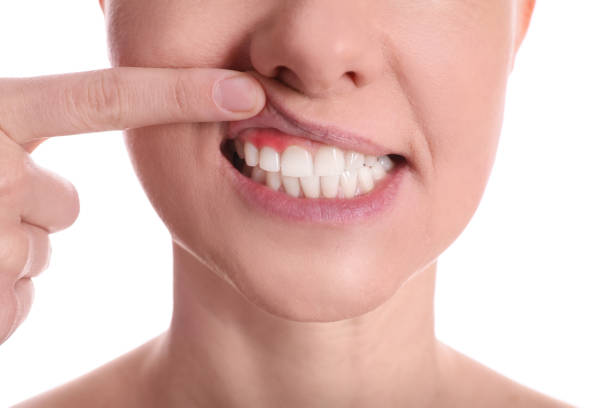Last Updated on: 27th August 2024, 04:40 am
The gums are soft, pink tissue that covers the bone in which the teeth are embedded. Having healthy and inflammation-free gums is crucial for good oral health and a brilliant smile. Prevention and good hygiene are the most effective methods to maintain healthy gums. However, if it is already too late and your gums are already diseased, we will discuss the available options on how to reverse and fix periodontal disease.
What is periodontitis?
Periodontitis or periodontal disease is a disorder of the gums caused primarily by poor hygiene. When there are no good dental cleaning habits, a hard layer of bacteria and food debris called calculus forms on the teeth, which generates an infection that attacks the gums. This causes inflammation, bleeding, and progressive destruction of the soft tissue surrounding the tooth. If this disease is not treated promptly, it can destroy the bone that supports the tooth, causing it to loosen and eventually fall out.
What causes periodontitis?
This disease is generally caused by poor oral hygiene, but there are also factors that increase the risk of developing it:
- Hormonal changes such as pregnancy and menopause.
- Tobacco and alcohol consumption.
- Genetic factors.
- Poor oral hygiene.
- Systemic diseases that enhance this disease, such as diabetes, AIDS, and patients with low defenses.

What are the symptoms of periodontitis?
The main symptoms of periodontitis are:
- Bad breath (halitosis)
- Inflammation of gums
- Bleeding gums
- Dental sensitivity to temperature changes (cold and heat)
- Receding gums
- Tooth mobility
If you want to learn more details about gum diseases, their causes, classification, and early signs, you can check out some related articles on gum diseases on our blog.
How to reverse and fix periodontal disease?
As mentioned earlier, the main cause of periodontitis is the accumulation of plaque and calculus caused by poor dental hygiene. Therefore, the treatment of this disease is heavily focused on improving hygiene and removing the cause of inflammation: plaque and calculus. Below are the most effective options for reversing periodontitis:
1. Proper Diagnosis
There are several types of periodontitis, some more severe than others, and treatment options depend on the stage of the disease. Therefore, the first step in reversing the disease is to see a dentist for proper diagnosis. Depending on the severity of the disease, the oral health professional may suggest various treatment options.
2. In-office Cleaning
While it is possible to remove soft bacterial plaque at home through brushing, it is impossible to remove calcified plaque or calculus. Therefore, to reverse periodontitis, it is essential to see a dentist for a deep cleaning using specialized instruments and equipment. In advanced cases, the periodontist may recommend a small surgery to lift a portion of the gum and facilitate cleaning of the roots of teeth in deep areas.
3. Modify Hygiene Habits
After a deep dental cleaning, the dentist will give recommendations for improving hygiene. It is essential to follow these suggestions to prevent bacterial plaque from adhering to the teeth and forming calculus. After a deep dental cleaning, the patient has a new mission: to keep their teeth free of plaque. Here are some tips to achieve this:
- The only way to remove dental plaque is through mechanical removal. This means that to maintain gum health, teeth should be brushed three times a day, making sure the bristles clean all surfaces.
- Judicious use of dental floss will help remove food debris and bacteria that are found in the spaces between teeth.
- Your dentist may recommend the use of an alcohol-free mouthwash, which will help control the bacteria that cause infection.
- It is possible that the treating professional may recommend the use of special toothpaste to help reduce inflammation of the gums.

4. Performing regular periodontal check-ups and maintenance
After a deep cleaning, the dentist will recommend that the patient attend regular appointments for maintenance treatment. These are less invasive cleanings that help preserve the initial work done. Depending on the progression of the disease, these cleanings will be scheduled at variable intervals. Likewise, this is important to verify that the treatment is working and to control for additional factors that may involve greater plaque retention, such as poorly placed restorations (fillings or crowns).
5. Quit smoking
Cigarettes contain irritants that damage the gums and prevent proper tissue healing. Therefore, even if cleanings, rinses, and other treatments are performed, they will not work as expected if the patient continues to smoke. Quitting smoking greatly promotes not only gum health but also overall health.
6. Treating bruxism and managing stress
Grinding teeth can overload the supporting tissues and worsen periodontitis. Therefore, it is important to consult with a dentist to evaluate the available options for treating bruxism. In many cases, this occurs due to inadequate stress management, so seeking help to cope with this situation is recommended.
What does reverse and fix periodontal disease mean?

It is clear that periodontitis is an advanced inflammation of the gum that causes destruction of the hard and soft tissues that support the tooth. When we talk about “reversing periodontitis,” we are referring to resolving this inflammation and restoring gum health. However, it is pertinent to clarify that in advanced stages, even if the infection is resolved, the lost tissue cannot be regained with the options mentioned above.
Can lost tissues be recovered?
In many cases, if periodontitis is treated in a timely manner, it is possible to recover lost tissue. For this, some additional surgical procedures are required:
- Surgeries to replace lost tissue: Soft tissue or bone grafts, tissue regeneration, AND among others.
- Laser therapy: Widely useful for improving gum treatment response, tissue regeneration, and healing.
Conclusion
Reversing periodontal disease requires joint work between the treating dentist and the patient. Unfortunately, there are no magic formulas to get rid of gum disease, and treatment requires discipline, habit changes, perseverance, and periodic cleaning procedures.
Contact us
If you have any questions about this or other topics, you can contact us at Channel Islands Family Dental as well as our page on Facebook. We look forward to your visit and we will make a timely diagnosis. Our dentists in Oxnard, Santa Paula, Ventura, Newbury Park, and Port Hueneme will be able to guide you toward the best treatment to take care of your health and give you back your best smile.
Bibliography
- Gum Disease Prevention. (Feb 8, 2020). American Academy of Periodontology. https://www.perio.org/for-patients/gum-disease-information/gum-disease-prevention/
- Gum Disease and Other Diseases. (Jun 21, 2019). American Academy of Periodontology. https://www.perio.org/for-patients/gum-disease-information/gum-disease-and-other-diseases/
- Non-Surgical Treatments. (Jun 21, 2019). American Academy of Periodontology. https://www.perio.org/for-patients/periodontal-treatments-and-procedures/non-surgical-treatments/
- Surgical Procedures. (Feb 5, 2020). American Academy of Periodontology. https://www.perio.org/for-patients/periodontal-treatments-and-procedures/surgical-procedures/
- Gum disease symptoms and treatments. (s. f.). https://www.nhsinform.scot/illnesses-and-conditions/mouth/gum-disease
- Periodontal Diseases. (s. f.). Johns Hopkins Medicine. https://www.hopkinsmedicine.org/health/conditions-and-diseases/periodontal-diseases



